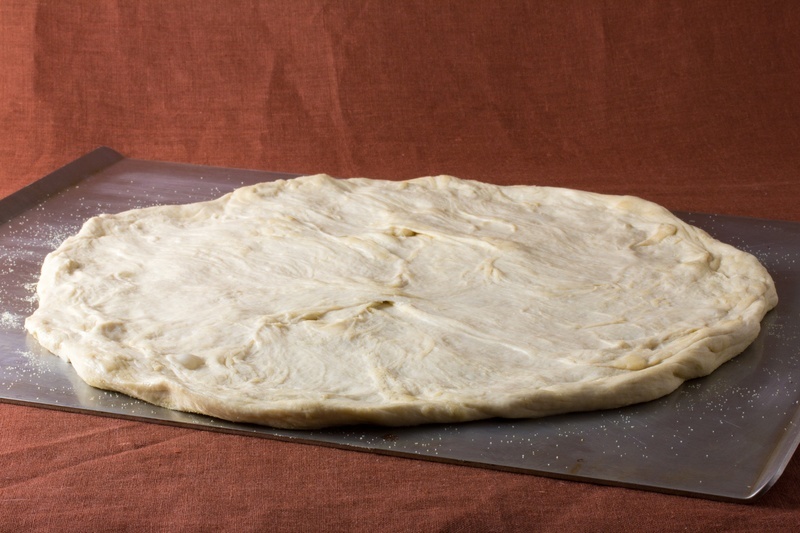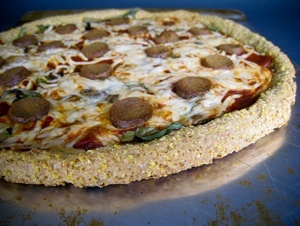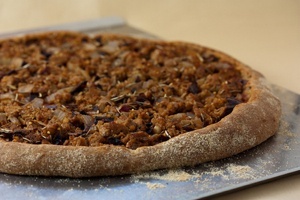Veganbaking.net
Vegan Baking Recipes
Vegan Bread Recipes
Vegan Pizza Crust Recipes
Easy Vegan Pizza Crust
Easy Vegan Pizza Crust
21

I haven't yet met anyone who isn't a raging pizza fan. It was one of the hardest foods for me to give up when I lit the vegan torch. Luckily, I've developed this Easy Vegan Pizza Crust recipe that's easy to make and features a rich flavor with a crispy exterior and chewy interior. This has come at a price. The uneven road leading to this crust has made past girlfriends almost dump me over failed pizza prospects. I've lost many highly anticipated meals and wasted lots of time. Yes, the lowly pizza crust depends on some fundamental ingredients and methods that are to be mastered in order to bake itself to crispy perfection.
How I found my preferred vegan pizza crust texture
This pizza crust takes the middle road between thin crust and thick crust. It doesn't contain much yeast because it gets what rise it needs from oven spring. Bread flour is paramount in this recipe because its higher protein content allows the crust to develop a crackly outer crust with a chewy interior. Olive oil is a dough tenderizer because it slightly inhibits gluten strands from bonding. This allows the crust to have just the right amount of chewiness without being too robust.This crust has a high moisture content and, as such, doesn't require excessive kneading. Stirring the dough is all that is necessary to work the moisture into the dough kick off gluten development that continues throughout fermentation.
Long term versus short term dough resting
Finally, you have the option of doing a long term rest with this dough to develop maximum flavor. Allowing the dough to sit in refrigerated for an extended period of time significantly builds complex flavor. This is because naturally occurring amylase enzymes in the flour slowly break out sugars from the starch in the flour. You can think of starches as a necklace and the enzymes cutting off the beads which are glucose molecules with their tiny little scissors. This activity has two benefits: It produces more food for the yeast so it can ferment the dough more effectively and produce more flavor. It also increases the sugar content in the dough. This sugar slightly caramelizes during baking, further building flavor. I recommend doubling or tripling this Easy Vegan Pizza Crust recipe and always keeping a batch in the freezer. This way all you need to do is move the dough from the freezer to the refrigerator about 24 hours before you want to make pizza for the best pizza with the least amount of effort.Despite the above steps I still classify this as an easy recipe. Don't get too confused with my scientific jibber jabber. The end result will just be really great pizza crust!
Find more Savory recipes on Veganbaking.net
Easy Vegan Pizza Crust Recipe
¾ cup + 3 Tablespoons warm water½ teaspoon active dry yeast
2 cups bread flour
¼ cup whole wheat flour
1 ¼ teaspoons salt
2 Tablespoons vegetable oil
1) Activate the yeast
In a small bowl, whisk together the warm water and yeast. Let it sit for about 10 minutes so the yeast activates.2) Whisk together the dry ingredients
In a medium mixing bowl whisk together the bread flour, whole wheat flour and salt.3) Form the dough
Add the water mixture and vegetable oil and stir with a large spoon until the dough comes together into a sticky ball.4) Mix the dough
If Using an Electric Mixer
Mix on medium speed for about 30 seconds or until the dough forms into a smooth, sticky ball and starts to pull away from the sides of the bowl.If Mixing by Hand
Use a large spoon and stir the dough clockwise for about 2 minutes, then reverse stirring directions and stir counter-clockwise for another 2 minutes or until the dough forms into a smooth, sticky ball and starts to pull away from the sides of the bowl.5) Let the dough rise
If you're doing an overnight rise
Place the dough in a freezer bag, flatten it to a disk, squeeze all the excess air out and let it sit in the refrigerator from 12 hours to 3 days. Storing the dough in the refrigerator for more than 3 days isn't recommended because it can discolor. Feel free to store it in the freezer for up to one month if you need to store it longer.Take the dough out of the refrigerator and allow it to reach room temperature, about 3 hours. Due to the small amount of yeast in the dough, it will not rise significantly.
If you're doing a conventional rise (the quick method)
Coat the dough with about 1 teaspoon of olive oil, cover the mixing bowl with a plastic bag and let the dough rise for about 1 ½ hours. The dough will not gain a significant of size during this rise.Degass the dough by pressing out any gas with open palms. Allow the dough to have another rise for about 1 ½ hours. Due to the small amount of yeast in this dough it will not rise considerably.

6) Prepare your toppings
Now that we have some downtime, let's prepare our toppings. I could write an entire book on pizza toppings but the basic premise is to sauté savory, flavorful ingredients at high heat so they're partially cooked by the time it goes on the pizza.Here's what I usually do: Heat some oil in a large pan or wok. Sauté onions in the oil with some salt and add some garlic and other spices if necessary. Deglaze the pan with a splash of flavorful liquid such as red or white wine, vinegar, beer or even water. Now add a protein element such as seitan, tofu or tempeh. The protein element will soak up these deglazing juices. Now add some aromatic spices such as basil, thyme, oregano or tarragon.
7) Preheat your oven and prepare your baking surface
Preheat your oven as high as it will go but not hotter than 1100F. Most come ovens have a dial that goes to 500F When I crank my oven to its maximum temperature it registers 525F on the oven thermometer. Liberally dust a baking sheet with semolina flour. Semolina flour will inhibit the crust from sticking while baking better than any other flour due to its hardness. It's worth having in your kitchen just for this purpose if you make pizza frequently.8) Position the dough on the baking sheet or cooking surface
Dampen your hands with water. Pick up the ball of dough and flatten it into a disc with your hands as you rotate the dough. Position the dough so it's resting on the back of your hands and slightly pull your hands out as you rotate the dough. When you get to the point of where you think the dough might tear, place it on the baking sheet or pizza stone and pull it into formation so it's about 13 inches in diameter. Do not crimp the edges of the dough; It will create an edge for you during baking.
9) Apply a layer of tomato paste to the pizza dough
Coat the dough with a thin coat of tomato paste. I prefer tomato paste because it allows the crust to not get waterlogged and reduces the chances of a 'soupy' pizza. Add the toppings you created in Step 6 but don't overdo it; pizza is a celebration of simplicity.10) Bake to perfection
Bake until the crust turns a deep golden color with some darker spots. At 525F this takes about 15 to 20 minutes. It's important to rotate the pizza 180 degrees halfway through the baking duration for even baking.11) Cool slightly and slice the vegan pizza
Allow the pizza to cool for about 10 minutes before slicing and serving. Store your pizza in a covered container at room temperature where it will keep for up to 3 days. This recipe makes one 13 inch Easy Vegan Pizza Crust.Vegan pizza ideas
Veggie Canadian bacon and pineappleTofu feta, kalamata olives, sun dried tomatoes and artichoke hearts
Tofu cheese with cauliflower and curry powder (indian style)
Garden style with caramelized onions, pine nuts and tons of other veggies
Tofu cheese with seitan sausages





